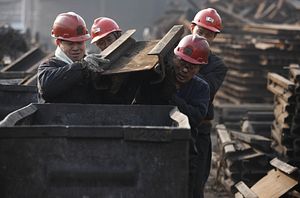In late February, hundreds of coal miners in Anyuan, where Mao Zedong first organized workers for the Great Strike of 1922, protested against their state employer over low wages and even poorer working conditions. On Wednesday, China wrapped up its most important legislative meeting of the year, announcing sweeping free market initiatives for economic recovery and long-term growth. Though clearly wary that other Anyuans will follow as a result, Beijing remains blind to their true significance to the country’s larger economic ambitions.
Indeed, for the better part of four decades of economic boom, China has maintained only a nominal commitment to socialism. The government generally took care of workers, even long after they were no longer employed in their most useful and efficient capacity. Given that security, citizens often willingly ignored some of the highest income inequality in the world. Now that China must make its economy market-oriented, it needs to remember its socialist roots more than ever to ensure that reforms are successful.
Appropriately, China chose Ronald Reagan’s slogan “supply-side economics” to represent its Thirteenth Five Year Plan for economic reform and recovery. Its cornerstones are straight out of a Hayekian playbook. Liberalize capital flows. Restructure or close inefficient state-owned enterprises. Cut taxes and red tape for private companies.
These same sweeping reforms were proposed when Chinese President Xi Jinping first took office in 2012. Unfortunately, past and future plans for implementation suggest that Beijing does not have the stomach to commit to its reform agenda.
First, China’s state sector has only grown. State-owned enterprises (SOEs) increased from 110,000 in 2008 to approximately 160,000 in 2015. Representing 145 percent of China’s GDP, state-owned assets have fueled the country’s investment-focused growth strategy thus far. Recently, SOEs have only gotten bigger through aggressive consolidation. The government has encouraged this trend because larger enterprises can, in theory, absorb more workers, staving off layoffs.
Second, the government has made little progress in streamlining regulations that prevent private enterprise, particularly small and medium-sized enterprises, from flourishing. Premier Li Keqiang has expressed his frustration on numerous occasions at local level officials who lack the imagination and initiative to take on these reforms. Part of the bottleneck is nationalist. Xi wants to establish national treasures to compete with the world’s largest multinationals. Fewer market protections for SOEs means they will find it even harder to stay afloat. Accounting for 40 percent of China’s output and 37 million jobs, they are essentially too big to fail.
This is not to say that Beijing isn’t preparing for that contingency. Indeed, the government has announced that it will be laying off 1.8 million workers in the coal and steel industries. It will also allocate 100 billion yuan ($15.27 billion) over the next two years to resettle the laid-off workers. Further downsizing will occur in other capital-intensive manufacturing sectors. The catch, however, is that resettlement funds will not be available until the SOEs have gone through the lengthy process of bankruptcy and debt repayment. Small wonder, then, that there is no time-frame for the current round of layoffs.
The common thread that runs through each of these deterrents to reform is the loss of jobs and household income. Greater marketization means the social contract between the Chinese people and the state will finally lose its socialist nature. The state will no longer be the main provider and employer. As workers struggle with the transition, they will take to the streets to protest, as they did over 500 times in January alone, and 2,700 times in 2015. Facing loss of power and social unrest, the CCP has returned to old tactics of anti-Western nationalism and heavy spending for new (and unnecessary) infrastructure, including new airports and rail lines to Tibet and Taiwan.
Here’s a better way forward: rewrite the Chinese social contract. Include social programs in an expanded fiscal stimulus package. Premier Li has announced that the budget deficit would increase by 3 percent this year, or $72 billion. With one of the lowest budget deficits and explicit debt levels in the world, Beijing can afford more and should spend it on stimulating demand. Higher social security for an aging population, increased minimum health insurance subsidies, unemployment benefits, job training (not merely resettlement to another SOE job) and tax cuts to stimulate spending—these are initiatives that will make the transition to a market-driven, consumption-based economy successful.
At the same time, the government should cut subsidies for the state sector and, instead, provide incentives for domestic and foreign private business. To stimulate innovation and create jobs, the Communist Party will have to look outside its firms and other large companies. Five hundred billion yuan in tax cuts for 2016 will certainly help, but institutional reforms are even more important.
These initiatives, taken together, can defuse the powder keg of dying state-owned employers and lay a smoother path for China’s difficult economic reform ambitions.
Rebecca Liao is a Director at Globality, Inc., a stealth startup in Silicon Valley that aims to restructure international trade. She is also a writer and China analyst. The opinions expressed here are her own.

































